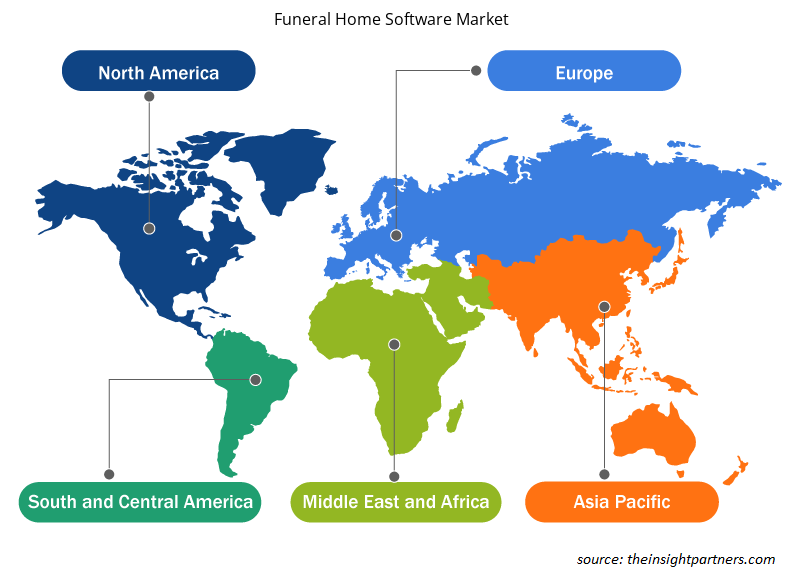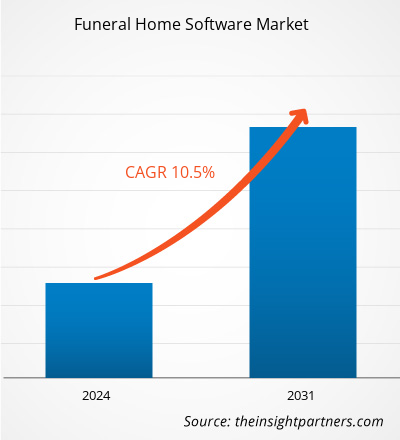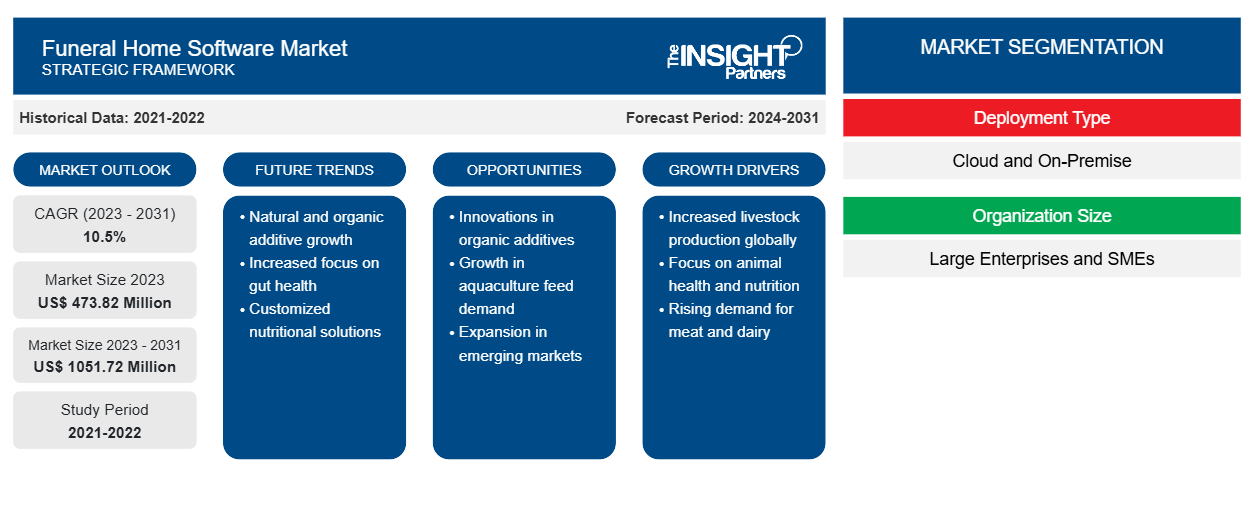Der Markt für Bestattungssoftware soll von 473,82 Millionen US-Dollar im Jahr 2023 auf 1.051,72 Millionen US-Dollar im Jahr 2031 anwachsen. Der Markt soll zwischen 2023 und 2031 eine durchschnittliche jährliche Wachstumsrate (CAGR) von 10,5 % verzeichnen. Das Wachstum der Digitalisierung und die Vorteile, die Bestattungssoftware bietet, werden voraussichtlich weiterhin die wichtigsten Trends auf dem Markt für Bestattungssoftware bleiben.
Marktanalyse für Bestattungssoftware
Der Anstieg der Zahl der Todesfälle führt zum Marktwachstum. Die Digitalisierung der Geschäftsabläufe weltweit hat an Bedeutung gewonnen, was weiter zur Einführung von Softwarelösungen für Bestattungsunternehmen geführt hat. Die Vorteile von Bestattungsunternehmenssoftware, wie z. B. einfache Dokumentenverwaltung, verbesserter Kundenservice, automatisierte Buchhaltung und andere, fördern die Nachfrage der Bestattungsunternehmen nach schnelleren und effizienteren Abläufen. Bestattungsunternehmen und -manager können mithilfe von Bestattungsunternehmenssoftware Beerdigungen arrangieren und mit Kunden interagieren. Bestattungsunternehmen können Softwarelösungen verwenden, um Terminplanung, Ressourcen und personalisierte Dienste zu verwalten. Häufig bietet das Programm ein Portal, über das Kunden Serviceanfragen stellen und Informationen über Verstorbene austauschen können.
Marktübersicht für Bestattungssoftware
Bestattungssoftware unterstützt Bestattungsunternehmen, Leichenhallen und Krematorien bei der Verwaltung und Abwicklung aller Aspekte des täglichen Betriebs. Sie automatisiert Buchhaltung, Inventar und Dokumentenverwaltung. Bestattungssoftware bietet vollständige Kontrolle über Backoffice-Aufgaben. Mit Frontoffice-Funktionen können Sie Bestattungsdienste verwalten, Dokumente teilen und unterzeichnen sowie Waren und Gedenkartikel auf der Website oder in sozialen Medien teilen.
Passen Sie diesen Bericht Ihren Anforderungen an
Sie erhalten kostenlos individuelle Anpassungen an jedem Bericht, einschließlich Teilen dieses Berichts oder einer Analyse auf Länderebene, eines Excel-Datenpakets sowie tolle Angebote und Rabatte für Start-ups und Universitäten.
-
Holen Sie sich die wichtigsten Markttrends aus diesem Bericht.Dieses KOSTENLOSE Beispiel umfasst eine Datenanalyse von Markttrends bis hin zu Schätzungen und Prognosen.
Treiber und Chancen auf dem Bestattungssoftwaremarkt
Digitalisierung begünstigt den Markt
Die Digitalisierung nimmt weltweit zu. Sie verändert das Geschäftsmodell, den Betrieb und das Kundenerlebnis. So hilft die Digitalisierung in der Bestattungsbranche, den Bestattungsprozess zu automatisieren. Die Digitalisierung von Bestattungsunternehmen bringt Effizienz in die gesamte Bestattungsunternehmensverwaltung. Mithilfe von Software können Kunden erforderliche Unterlagen digital unterzeichnen, ohne physisch anwesend sein zu müssen. Bestattungsunternehmenssoftware hilft Bestattungsunternehmen dabei, Aufnahme, Lieferzeiten, Servicepläne und Einladungen zu organisieren. Dies ermöglicht ihren Kunden ein positives Erlebnis in einer schwierigen Zeit. Dokumente wie Trauer- oder Sterbeurkunden können importiert und digital gespeichert werden. Diese Plattformen bieten Ressourcen zum Archivieren von Daten über Bestattungsvorkehrungen und Verstorbene. Mithilfe von Bestattungsunternehmenssoftware kann der Bestattungsunternehmensbetreiber den Benutzern bei der Planung bevorstehender Dienstleistungen und beim Erstellen einer Aufzeichnung vergangener Dienstleistungen helfen. Viele haben die Möglichkeit, Blumen, Bilder und andere personalisierte Elemente für Dienstleistungen zu kaufen. Einige verfügen auch über Tools zum Einchecken in Bestattungsregister. Berichte können von mehreren Bestattungssoftwareprogrammen erstellt und an Datenbankverwaltungs- oder Buchhaltungssoftware übermittelt werden.
Anstieg der Todesfälle weltweit – Eine Chance auf dem Markt für Bestattungssoftware
Mit dem veränderten Lebensstil und den veränderten Essgewohnheiten steigt die Zahl der Herz-Kreislauf-Erkrankungen weltweit. Faktoren wie Luftverschmutzung, Bluthochdruck, Tabakkonsum und erhöhter Cholesterinspiegel sind einige der Faktoren, die zu der steigenden Zahl der Todesfälle führen. Laut der World Heart Federation (WHF) stieg die Zahl der Todesfälle durch Herz-Kreislauf-Erkrankungen weltweit von 12,1 Millionen im Jahr 1990 auf 20,5 Millionen im Jahr 2021. Der World Heart Report wurde auf dem World Heart Summit 2023 veröffentlicht. Der Anstieg der Todesfälle aus bestimmten Gründen führte also zu einem Anstieg der Einsätze in Bestattungsunternehmen. Die Einführung von Bestattungssoftware wird Bestattungsunternehmen dabei helfen, Bestattungsvorgänge effizient zu verwalten. Der Anstieg der Todesfälle stellt daher eine Chance für Marktwachstum dar, da er die Bestattungsunternehmen dazu ermutigen wird, Lösungen zu übernehmen, um den Prozess und die Dokumentation effektiv zu verwalten.
Marktbericht zur Bestattungsunternehmenssoftware – Segmentierungsanalyse
Wichtige Segmente, die zur Ableitung der Marktanalyse für Bestattungssoftware beigetragen haben, sind Produkttyp und Anwendung.
- Basierend auf den Komponenten ist der Markt in Software und Dienstleistungen unterteilt. Das Softwaresegment hatte im Jahr 2023 einen größeren Marktanteil.
- Nach Bereitstellung ist der Markt in Cloud und On-Premise segmentiert. Das On-Premise-Segment hielt im Jahr 2023 den größten Marktanteil.
- Nach Unternehmensgröße ist der Markt in KMU und Großunternehmen segmentiert. Das Segment der Großunternehmen hatte im Jahr 2023 den größten Marktanteil.
Marktanteilsanalyse für Bestattungssoftware nach geografischer Lage
Der geografische Umfang des Marktberichts für Bestattungssoftware ist hauptsächlich in fünf Regionen unterteilt: Nordamerika, Asien-Pazifik, Europa, Naher Osten und Afrika sowie Südamerika/Süd- und Mittelamerika.
In Bezug auf den Umsatz hatte Nordamerika den größten Marktanteil im Bereich Bestattungsunternehmenssoftware. Die USA, Kanada und Mexiko gehören zu den wichtigsten Ländern Nordamerikas. Die Region ist ein früher Anwender technologisch fortschrittlicher Lösungen, was einer der Schlüsselfaktoren für das Marktwachstum ist. Die Region beherbergt Akteure auf dem Markt für Bestattungsunternehmenssoftware, darunter Aldor Solutions, FuneralTech, Lytesoft und viele andere, die den Marktanteil der Region stärken.
Regionale Einblicke in den Markt für Bestattungssoftware
Die regionalen Trends und Faktoren, die den Markt für Bestattungssoftware während des Prognosezeitraums beeinflussen, wurden von den Analysten von Insight Partners ausführlich erläutert. In diesem Abschnitt werden auch Marktsegmente und Geografie für Bestattungssoftware in Nordamerika, Europa, im asiatisch-pazifischen Raum, im Nahen Osten und Afrika sowie in Süd- und Mittelamerika erörtert.

- Erhalten Sie regionale Daten zum Markt für Bestattungssoftware
Umfang des Marktberichts zur Bestattungsunternehmenssoftware
| Berichtsattribut | Details |
|---|---|
| Marktgröße im Jahr 2023 | 473,82 Millionen US-Dollar |
| Marktgröße bis 2031 | 1051,72 Millionen US-Dollar |
| Globale CAGR (2023 - 2031) | 10,5 % |
| Historische Daten | 2021-2022 |
| Prognosezeitraum | 2024–2031 |
| Abgedeckte Segmente |
Nach Bereitstellungstyp
|
| Abgedeckte Regionen und Länder |
Nordamerika
|
| Marktführer und wichtige Unternehmensprofile |
|
Marktteilnehmerdichte für Bestattungssoftware: Auswirkungen auf die Geschäftsdynamik verstehen
Der Markt für Bestattungssoftware wächst rasant. Dies wird durch die steigende Nachfrage der Endnutzer aufgrund von Faktoren wie sich entwickelnden Verbraucherpräferenzen, technologischen Fortschritten und einem größeren Bewusstsein für die Vorteile des Produkts vorangetrieben. Mit der steigenden Nachfrage erweitern Unternehmen ihr Angebot, entwickeln Innovationen, um die Bedürfnisse der Verbraucher zu erfüllen, und nutzen neue Trends, was das Marktwachstum weiter ankurbelt.
Die Marktteilnehmerdichte bezieht sich auf die Verteilung von Firmen oder Unternehmen, die in einem bestimmten Markt oder einer bestimmten Branche tätig sind. Sie gibt an, wie viele Wettbewerber (Marktteilnehmer) in einem bestimmten Marktraum im Verhältnis zu seiner Größe oder seinem gesamten Marktwert präsent sind.
Die wichtigsten auf dem Markt für Bestattungssoftware tätigen Unternehmen sind:
- N / A
Haftungsausschluss : Die oben aufgeführten Unternehmen sind nicht in einer bestimmten Reihenfolge aufgeführt.

- Überblick über die wichtigsten Akteure auf dem Markt für Bestattungssoftware
Neuigkeiten und aktuelle Entwicklungen zum Markt für Bestattungssoftware
Der Markt für Bestattungssoftware wird durch die Erhebung qualitativer und quantitativer Daten nach Primär- und Sekundärforschung bewertet, die wichtige Unternehmensveröffentlichungen, Verbandsdaten und Datenbanken umfasst. Im Folgenden finden Sie eine Liste der Entwicklungen auf dem Markt:
- Im März 2022 kündigte CTV Software Pty Ltd. Funeral Buddy 6.0 mit neuen Funktionen an. Seine neuen Funktionen für Filialen, Familienzugang und andere Verbesserungen verbessern die gesamte Bestattungsverwaltung. Mit der zusätzlichen Funktion erhält die Familie Anmeldeinformationen und hat schnellen Zugriff auf die Überweisungsdokumente. (Quelle: CTV Software Pty Ltd., Pressemitteilung, 2022)
- Im März 2023 führte Strategic Funeral Resources (SFR) vier preisgünstige Social-Media-Werbeprogramme ein, die Bestattungsunternehmen dabei helfen sollen, die Kundenbindung zu erhöhen und die Rentabilität zu steigern. Jedes Programm ist in einem von zwei Paketen (Standard und Preferred) erhältlich und viele bieten außergewöhnliche Anpassungsfunktionen. Die Pakete integrieren die proprietäre künstliche Intelligenzsoftware Automated Virtual Arranger (AVA). Durch die Digitalisierung des Bestattungsunternehmens oder eines Mitarbeiters nutzt der AVA-Prozess die besten Arten menschlicher Interaktion – ansprechende, herzliche, emotionale Verbindungen – und kombiniert sie mit revolutionärer KI-Technologie, um ein lebensechtes Inhaltserlebnis für die Zielgruppe eines Unternehmens zu schaffen. (Quelle: National Funeral Directors Association, Pressemitteilung, 2023)
Marktbericht zu Bestattungssoftware – Umfang und Ergebnisse
Der Bericht „Marktgröße und Prognose für Bestattungssoftware (2021–2031)“ bietet eine detaillierte Analyse des Marktes, die die folgenden Bereiche abdeckt:
- Marktgröße und Prognose auf globaler, regionaler und Länderebene für alle wichtigen Marktsegmente, die im Rahmen des Projekts abgedeckt sind
- Marktdynamik wie Treiber, Beschränkungen und wichtige Chancen
- Wichtige Zukunftstrends
- Detaillierte PEST/Porters Five Forces- und SWOT-Analyse
- Globale und regionale Marktanalyse mit wichtigen Markttrends, wichtigen Akteuren, Vorschriften und aktuellen Marktentwicklungen
- Branchenlandschaft und Wettbewerbsanalyse, einschließlich Marktkonzentration, Heatmap-Analyse, prominenten Akteuren und aktuellen Entwicklungen
- Detaillierte Firmenprofile
- Historische Analyse (2 Jahre), Basisjahr, Prognose (7 Jahre) mit CAGR
- PEST- und SWOT-Analyse
- Marktgröße Wert/Volumen – Global, Regional, Land
- Branchen- und Wettbewerbslandschaft
- Excel-Datensatz
Aktuelle Berichte
Verwandte Berichte
Erfahrungsberichte
Grund zum Kauf
- Fundierte Entscheidungsfindung
- Marktdynamik verstehen
- Wettbewerbsanalyse
- Kundeneinblicke
- Marktprognosen
- Risikominimierung
- Strategische Planung
- Investitionsbegründung
- Identifizierung neuer Märkte
- Verbesserung von Marketingstrategien
- Steigerung der Betriebseffizienz
- Anpassung an regulatorische Trends























 Kostenlose Probe anfordern für - Markt für Bestattungssoftware
Kostenlose Probe anfordern für - Markt für Bestattungssoftware